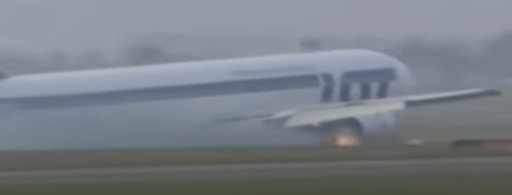Nalliah Thayabharan
Newbie
- Joined
- Dec 30, 2024
- Posts
- 2
At 8:54 am the Boeing 737-800NG operating the Jeju Air Flight 2216 was authorized to land at Muan International Airport in South Korea. As the plane was preparing to land, it was warned at 8:57 am about the potential for a bird strike. A minute later, it issued a mayday alert.At 9:00 a.m, the plane attempted an emergency landing, being forced to go around again after the landing gear was not deployed. A minute later, it received authorization to attempt a landing from the opposite direction. Most pilots are trained for situations like this.
The crash occurred as the aircraft attempted to perform a belly landing,touching down 1,200m along the runway, sliding down the runway on the engine nacelles with a sustained nose-high attitude. It continued 250m past the runway threshold before colliding with an embankment holding the ILS array and exploding.
If they were in a stabilised approach the landing gear would be down WAY before the bird strike zone. The Boeing 737-800NG did a go-around with no problems.
Then nothing like this has ever happened, a plane comes in without landing gear, speed close to take off and on at least at 50% power until it contacted an object on the ground - Pilots missed alternate landing gear extension, alternate flap extension, approach and landing speed judgement, diversion, not correctly configure the aircraft for landing, way too fast, way too far down the runway before touchdown, 15-degree nose-up. Either a complete loss of throttle control or the pilots tried to climb out and it was too late.
We have seen pilots ignore repeated alarms in the coughpit, warnings from the GPWS many times including PIA8303 and Air France 447. This is more than likely another example of a crew doing everything other than what they should have been doing.
There are 3 hydraulic systems aboard the 737 - system A, B and Stand by. The A system powers the landing gear for retraction, extension, and nose wheel steering. The B system powers the flaps and leading edge devices, with an electric backup that can extend and retract the flaps. All have redundancy but a complete failure of all 3 hydraulic systems and the backup electrical system to operate the flaps is damn near impossible.
APU can provide electrical power to the electric motor driven pumps (EMDP's) and thus supply hydraulic pressure. One of the amazing things that Captain Sullenberger did, when they first hit the birds on takeoff was immediately start the APU, before he did anything else, as I guess he knew he might lose both engine power from the birds.
Hydraulics not required for emergency use of flaps and landing gear on 737. Pilots should be able to manually drop the landing gear no matter what. Landing gear can be manually extended with the 3 red handles-Right Main, Nose and Left Main-behind crew seats on the floor, physically connected to each strut that when pulled releases the gear which falls and locks into place by their own weight and wind drag. On Boeing 737-800 NG, the manual extension handles will function with the landing gear lever in any position.
However it does take time. Crew only gave themselves 7 minutes to execute check lists and final between loss of signal on initial approach and attempted go around.
There’s really no explanation for the gear being retracted other than the pilot forgot. The Control Tower should have informed them that their landing gear was not down though. The aircraft won’t even allow use of thrust reversers unless you have main gear strut compression, in this case with the gear still retracted there may not be any thrust reversers nor spoilers available.
The lack of ADS-B during the final landing implies a complete loss of power.
Passengers from the same aircraft 2 days ago reported one engine kept switching off during the flight. The aircraft diverted to Incheon International Airport while operating Jeju Air flight 8135 to Beijing Daxing International Airport originating from Jeju International Airport. The aircraft was in cruise flight transiting the Yellow Sea at FL320 when the flight crew declared an emergency. A descent and diversion to Searle Incheon International Airport (ICN) was then carried out. Flight crew squawked emergency transponder code 7700, declaring an emergency when established on the descent on track to the diversion airport.
The aviation industry is built on redundancy and there are very few single-point failures in airplane design or airplane operations A combination of unlucky factors including ongoing mechanical issues, a bird strike, and poor crew resource management caused this crash. Also it appears the airport was expecting an emergency landing.
MWX runway 19 has a Landing Distance 2800m. The end of Runway 19 is about 6 m below its threshold. The embankment is to raise the localizer array, to compensate for the runway slope. However, within the United States and Canada these would be required to be mounted on frangible support structures. You want the support structure to break-away and cause as minimal damage as possible in a scenario like this. You would not be allowed to construct an earth mound like this within the runway overruns. This localizer is about 150m off the overrun, which would violate North American Airfield criteria, but it's a Korean Airport so regulations are different.
My guessing
Birdstrike with severe damage on the right engine and crew incorrectly shuts down the left engine, losing both engines.
Immediate turn back to land tailwind opposite direction.
Split decisions, forgot the landing gear.
The plane wasn't ready for that belly landing at all.
-Nalliah Thayabharan
The crash occurred as the aircraft attempted to perform a belly landing,touching down 1,200m along the runway, sliding down the runway on the engine nacelles with a sustained nose-high attitude. It continued 250m past the runway threshold before colliding with an embankment holding the ILS array and exploding.
If they were in a stabilised approach the landing gear would be down WAY before the bird strike zone. The Boeing 737-800NG did a go-around with no problems.
Then nothing like this has ever happened, a plane comes in without landing gear, speed close to take off and on at least at 50% power until it contacted an object on the ground - Pilots missed alternate landing gear extension, alternate flap extension, approach and landing speed judgement, diversion, not correctly configure the aircraft for landing, way too fast, way too far down the runway before touchdown, 15-degree nose-up. Either a complete loss of throttle control or the pilots tried to climb out and it was too late.
We have seen pilots ignore repeated alarms in the coughpit, warnings from the GPWS many times including PIA8303 and Air France 447. This is more than likely another example of a crew doing everything other than what they should have been doing.
There are 3 hydraulic systems aboard the 737 - system A, B and Stand by. The A system powers the landing gear for retraction, extension, and nose wheel steering. The B system powers the flaps and leading edge devices, with an electric backup that can extend and retract the flaps. All have redundancy but a complete failure of all 3 hydraulic systems and the backup electrical system to operate the flaps is damn near impossible.
APU can provide electrical power to the electric motor driven pumps (EMDP's) and thus supply hydraulic pressure. One of the amazing things that Captain Sullenberger did, when they first hit the birds on takeoff was immediately start the APU, before he did anything else, as I guess he knew he might lose both engine power from the birds.
Hydraulics not required for emergency use of flaps and landing gear on 737. Pilots should be able to manually drop the landing gear no matter what. Landing gear can be manually extended with the 3 red handles-Right Main, Nose and Left Main-behind crew seats on the floor, physically connected to each strut that when pulled releases the gear which falls and locks into place by their own weight and wind drag. On Boeing 737-800 NG, the manual extension handles will function with the landing gear lever in any position.
However it does take time. Crew only gave themselves 7 minutes to execute check lists and final between loss of signal on initial approach and attempted go around.
There’s really no explanation for the gear being retracted other than the pilot forgot. The Control Tower should have informed them that their landing gear was not down though. The aircraft won’t even allow use of thrust reversers unless you have main gear strut compression, in this case with the gear still retracted there may not be any thrust reversers nor spoilers available.
The lack of ADS-B during the final landing implies a complete loss of power.
Passengers from the same aircraft 2 days ago reported one engine kept switching off during the flight. The aircraft diverted to Incheon International Airport while operating Jeju Air flight 8135 to Beijing Daxing International Airport originating from Jeju International Airport. The aircraft was in cruise flight transiting the Yellow Sea at FL320 when the flight crew declared an emergency. A descent and diversion to Searle Incheon International Airport (ICN) was then carried out. Flight crew squawked emergency transponder code 7700, declaring an emergency when established on the descent on track to the diversion airport.
The aviation industry is built on redundancy and there are very few single-point failures in airplane design or airplane operations A combination of unlucky factors including ongoing mechanical issues, a bird strike, and poor crew resource management caused this crash. Also it appears the airport was expecting an emergency landing.
MWX runway 19 has a Landing Distance 2800m. The end of Runway 19 is about 6 m below its threshold. The embankment is to raise the localizer array, to compensate for the runway slope. However, within the United States and Canada these would be required to be mounted on frangible support structures. You want the support structure to break-away and cause as minimal damage as possible in a scenario like this. You would not be allowed to construct an earth mound like this within the runway overruns. This localizer is about 150m off the overrun, which would violate North American Airfield criteria, but it's a Korean Airport so regulations are different.
My guessing
Birdstrike with severe damage on the right engine and crew incorrectly shuts down the left engine, losing both engines.
Immediate turn back to land tailwind opposite direction.
Split decisions, forgot the landing gear.
The plane wasn't ready for that belly landing at all.
-Nalliah Thayabharan

















